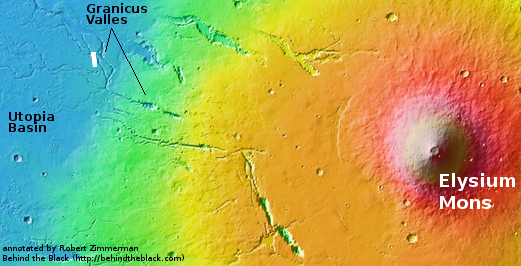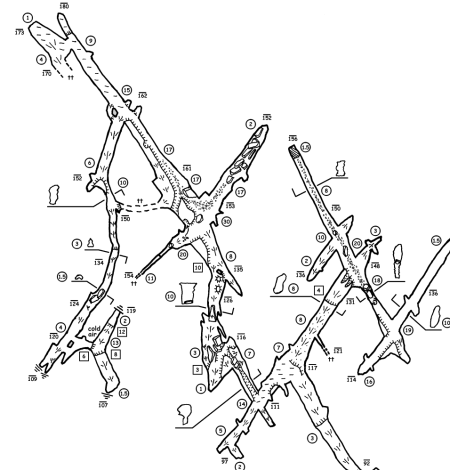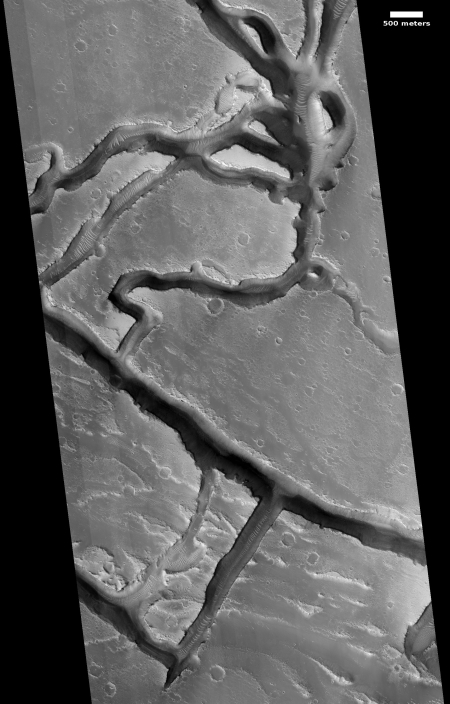Volcanic rivers on Mars
Cool image time! The photo on the right, cropped and reduced to post here, was part of the November image release from the high resolution camera on Mars Reconnaissance Orbiter (MRO). If you click on the image you can see the full resolution picture.
The uncaptioned release webpage is dubbed “Faults in Granicus Valles.” The image itself only shows a small part of Granicus Valles, named after a river in Turkey, that flows down from the estern slopes of the giant volcano Elysium Mons. While far smaller than the four big Martian volcanoes in the Tharsis region to the east and near Marines Valles (which I highlight often), Elysium Mons still outshines anything on Earth at a height of almost 30,000 feet and a width of 150 miles. It sits at about the same northern latitude of Olympus Mons, but all by itself, rising up at the very northern edge of the transition zone between the southern highlands and the northern plains, with the vast Utopia Basin, the second deepest basin on Mars, to the west.

Granicus Valles itself is almost five hundred miles long. At its beginning it flows in a single straight fault, but once it enters the northern plains of Utopia Basin it begins to meander and break up into multiple tributaries. The MRO image above shows only a tiny portion in the northern plains, as illustrated by the white box in the overview map to the left.
This “river” was almost certainly created by lava flows coming down from Elysium Mons, following the major faults in the geology. The image illustrates this, with its several tributaries breaking off at almost straight right angles from each other. To my eye, as the lava flowed downhill, it sometimes was sharply redirected by a new fault running perpendicular to the previous flow.

What struck me especially about this image is how much these canyons resemble the numerous cave maps I have drawn, as shown by the tiny excerpt from one such map on the right. In a cave map, you draw the walls and floor. Ceiling features are sometimes indicated, but in general the ceiling is transparent so that a viewer looking at the map sees it from above. Ceiling height is indicated by the numbers in the circles. With caves the water is finding the easiest path through the limestone, often sharply being redirected because it hits a new fault. Thus you often get straight passages turning at right angles, then later meandering like a river should the limestone become less resistant.
In this context, Granicus Valles here to me seems almost like a cave with no ceiling, as if the lava flow ripped off the ceiling, preventing a lava tube from forming.
Considering the different gravity and temperatures on Mars, it should not surprise us if lava flows differently here, and might not even form lava tubes in many of the circumstances on Earth where it would be expected. Maybe on Mars large lava flows shape canyons, like Granicus Valles. The lighter gravity and colder temperatures and different lava materials do not allow a ceiling crust to form.
These factors might also provide an explanation for why the Martian pits near the volcano Arsia Mons that I highlighted earlier this week seemed isolated with no evidence of lava tubes extending away from them. The formation processes are just different enough and our data is just insufficient enough to make explaining these features difficult.
On Christmas Eve 1968 three Americans became the first humans to visit another world. What they did to celebrate was unexpected and profound, and will be remembered throughout all human history. Genesis: the Story of Apollo 8, Robert Zimmerman's classic history of humanity's first journey to another world, tells that story, and it is now available as both an ebook and an audiobook, both with a foreword by Valerie Anders and a new introduction by Robert Zimmerman.
The print edition can be purchased at Amazon or from any other book seller. If you want an autographed copy the price is $60 for the hardback and $45 for the paperback, plus $8 shipping for each. Go here for purchasing details. The ebook is available everywhere for $5.99 (before discount) at amazon, or direct from my ebook publisher, ebookit. If you buy it from ebookit you don't support the big tech companies and the author gets a bigger cut much sooner.
The audiobook is also available at all these vendors, and is also free with a 30-day trial membership to Audible.
"Not simply about one mission, [Genesis] is also the history of America's quest for the moon... Zimmerman has done a masterful job of tying disparate events together into a solid account of one of America's greatest human triumphs."--San Antonio Express-News


